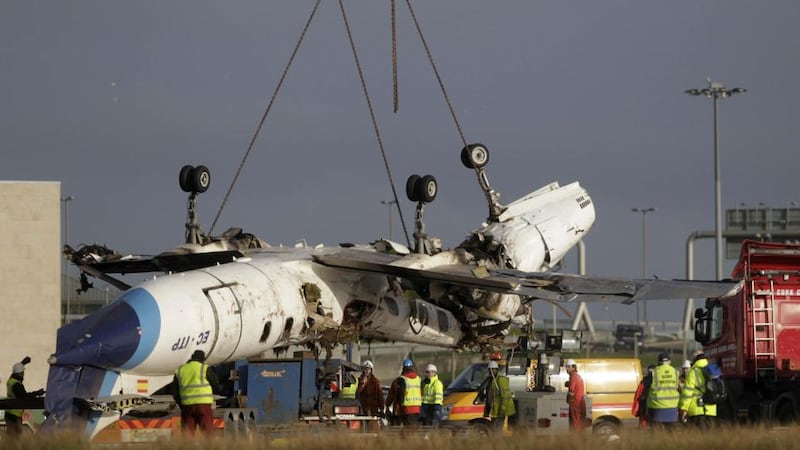A report into an aircraft crash that claimed the lives of six people at Cork Airport in 2011 has identified poor operational decisions by the crew in continuing to attempt to land in poor visibility as being a significant factor in the cause of the crash.
The report by the Air Accident Investigation Unit into the Manx2. com flight from Belfast to Cork, which crashed at Cork Airport on February 10th, 2011, on its third approach, found the aircraft continued with its approach to land in conditions below the required level of visibility.
Spanish pilot, Jordi Sola Lopez (31) from Manresa in Spain, and co-pilot Andrew Cantle (27) from Sunderland, were killed, along with four of their 10 passengers, when the aircraft crashed while attempting to land on the main runway.

The passengers killed were businessman Richard Noble (48), from Belfast; accountant Patrick Cullinan (45), originally from Co Tyrone but living in Belfast; businessman Brendan McAleese (39), from Co Antrim; and harbour master, Michael Evans (51), from Belfast.
The investigation established that a go-around was initiated during the third approach at a height of approximately 30.5m (100ft), but the aircraft then rolled to its left and then to its right, resulting in the right wing-tip striking the runway and the aircraft flipping over.
It travelled on some 189m from the impact point and came to rest on soft ground 72m from the centre of the runway, before fire broke out in both engines. Cork Airport fire service extinguished the fire very quickly.
Decision height
The 244-page report found the crew continued with their descent below the decision height (the height at which the pilots must have a certain visibility of the landing area) on all three approaches without having acquired the adequate visual reference points.
The report also found there was an unco-ordinated operation of the flight and engine controls by the two crew, and power was reduced below the normal levels, leading to a loss of control of the aircraft when the go-around was attempted on its third approach.
The investigation also found the flight was taken without adequate consideration of the weather conditions at Cork Airport.
It found air traffic control personnel at Cork Airport performed their duties in accordance with procedures and promptly sounded the alarm when they lost radio control with the aircraft.
According to the air accident unit, the purpose of the investigation was not to apportion blame or liability to anyone. It said the failings by the crew stemmed from poor training and operational control of the flight, which involved three different companies.
The report notes the flight involved three separate undertakings: the operator, Flightline SL of Barcelona, which had a Spanish air operator certificate; Manx2.com, which sold the tickets; and Air Lada of Seville which supplied the aircraft and the crew.
The report added that tiredness and fatigue on the part of the crew was a factor and said neither Mr Lopez nor Mr Cantle had sufficient rest prior to starting duty that morning, while two days prior to the accident, Mr Cantle had exceeded flight and duty time limitations.
Tiredness
"It is likely that the commander [Mr Lopez] and particularly the co-pilot [Mr Cantle], who had flown three raw data approaches, were suffering from tiredness and fatigue at the time of the accident," the report notes.
The report adds Mr Lopez was inadequately trained in the command role and ill-prepared for the situation he found himself in, while the pairing of a newly promoted commander with a co-pilot who had just joined the operator was inappropriate and contrary to EU regulations.
A lawyer representing some of those injured and those who lost loved ones said the investigation highlighted the need for greater monitoring and oversight of low-cost operators by European aviation authorities.
“This comprehensive report reveals a ‘low-cost, low-safety operation’, seemingly not spotted by the European regulators. The pilots ran three red stop lights in poor weather with tragic results,” said James Healy Pratt, head of aviation and travel at London firm Stewarts Law LLP.
“Lives were needlessly lost and others were seriously injured in what was a preventable accident. Air safety is a right and not a privilege and we are calling on the EU air safety commission to prevent the loss of future innocent lives in similar circumstances.”
Meanwhile, the father of the pilot of the aircraft, Jordi Sola Lopez, spoke of his anguish and said he hoped people would not blame his son.
REPORT: Safety Recommendations
The Air Accident Investigation Unit made 11 safety recommendations in its report on the Manx2 crash, with four of these being made to the European Commission Directorate responsible for Commercial Air Transport and three to the European Aviation Safety Agency. Among the safety recommendations are:
> The director general for mobility and transport at the European Commission should review the obligations of member states to implement penalties for transgressions including flight-time limitations.
> The European Aviation Safety Agency should provide use of successive approaches to an aerodrome where a landing cannot be made due to weather conditions.
> The agency should review regulations to ensure it contains the appropriate syllabus for appointment to commander and that an appropriate level of command training and checking is carried out.
> Flight operator Flightline SL should implement appropriate training for personnel responsible for flight safety and accident prevention.
> The Agencia Estatal de Seguridad Aerea (Spanish Civil Aviation Regulatory Authority) should review its policy with regard to continuing oversight of air carriers, in particular those operating remotely.








